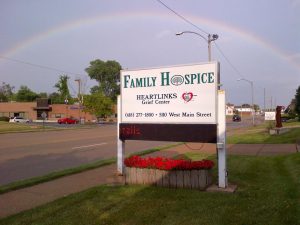New data, book shed light on opioid issues in Metro East
By Bob Pieper For Chronicle Media — September 5, 2019
“Heartbroken – Grief and Hope Inside the Opioid Crisis” details the opioid crisis as it has impacted the St. Louis/Metro East region. The book is available at local bookstores and on Amazon.
As Metro East, like much of the nation, struggles with a prolonged opioid epidemic, a trio of local experts is hoping to help families cope with a growing problem: the loss of a loved one to opioid abuse.
Misuse of opioids across the St. Louis region has risen dramatically over the last decade; with a 400 percent increase in opioid-related deaths, according to Ellen Krohne, primary author of “Heartbroken – Grief and Hope Inside the Opioid Crisis.”
And Madison County has been one of the hardest hit areas, adds epidemiologist and book co-author Matthew Ellis, of the Washington University School of Medicine in St. Louis.
In 2015, Madison County had 25.9 opioid related deaths for every 100,000 residents – the highest opioid death rate in the state, he notes. St. Clair County had a smaller by still significant opioid death rate of 10.9 that year.
An ambitious Illinois Department of Health Program (IDOH) program aims to slash opioid related deaths by up to one third in 2020.
Increased treatment funding in Madison and St. Clair counties offers hope that a reduction in opioid deaths will be seen in Metro East, according to Ellis.
However, opioid-related deaths will continue to extract a cost that is not easily measured in objective terms: grief and stigma endured by the surviving family members, Krohne says.
Her new book is one of several, now in print, addressing issues faced by those who have who have lost family to the opioid crisis.
However, “Heartbroken” uniquely offers a handbook with “ways to help those grieving from an addiction loss, specific actions we can all take to help stem the crisis and prevent future young people from this heartbreak, and stop stigma,” Krohne said.
Included is a list of locally and nationally available resources for those seeking help with addiction, as well as a listing of resources for grief support.
It is the only book centered around the opioid epidemic in the St. Louis and Metro East areas, Krohne adds.
A series of seven profiles of opioid abusers serves to illustrate how opioid problems arise in almost any family, Krohne said.
Official release of the book was Thursday, Aug. 29, with a book signing at the Main Street Brewing Company Banquet and Events Center in Belleville.
The book in already available through Amazon and Krohne’s website (www.ellenkrohne.com).
All profits from the book go to the Belleville-based Heartlinks Grief Center, which for 23 years has provided comprehensive grief counseling services across a six-county area of southern Illinois. Services are offered in Madison County through a satellite facility in Edwardsville.
Tackling the opioid crisis in Metro East represents something of a change for Krohne, who for years helped lead economic development in the area.
A former international business consultant and vice-president of customer service for Illinois Power Company, Krohne served as executive director of the influential Metro East business roundtable, the Leadership Council of Southwestern Illinois, until her retirement three years ago.
She became concerned over the opioid epidemic after attending an IDOH program at the Washington County Health Department, held in early 2018 to launch the state’s opioid response plan in Southwestern Illinois.
She has since completed a certification in The Opioid Crisis in America at Harvard University.
Co-author Ellis, a pharmacoepidemiologist with a focus in prescription opioids, has studied the opioid epidemic for over a decade.
Also contributing to the book is Heartlinks Director Diana Cuddeback of Caseyville, who helped launch the Heartlinks outreach program as a part of Belleville’s Family Hospice Services two decades ago.
While some Metro East political leaders still debate the severity of the local opioid epidemic, the evidence is clear to Krohne and her co-authors —particularly in Madison County.
The county had 8.3 opioid deaths for each 100,000 residents in 2006; increasing to 32.1 in 2017.
Some 760 people died from opioids — mainly heroin and fentanyl — in the St. Louis area during 2017; the most recent year for which complete data is available. Eighty-two of those deaths were in Madison County, with another 21 in St. Clair County.
However, most telling may be recently released U.S. Drug Enforcement Administration (DEA) data on wholesale shipments of pain pill from manufacturers and distributors.

All profits from the sales of “Heartbroken – Grief and Hope Inside the Opioid Crisis” go to the Belleville-based Heartlinks Grief Center, which provides grief counseling services across a six-county area of southern Illinois. Heartlinks Director Diana Cuddeback contributed to the book. (Photo courtesy of Heartlinks Grief Center)
An analysis by the Washington Post suggests wide variability across the St. Louis region in pill dispensing; with per-capita pill shipments to Madison County nearly double those compared to the adjacent City of St. Louis, according to Ellis. Shipment rates to some rural counties were even higher.
The DEA data shows pill shipments to many areas increased, even as the opioid crisis worsened and began drawing attention, according to the Post.
However, for all the data, Krohne and the co-authors believe their book’s profiles of opioid users, most from Metro East, may offer the most meaningful insights into the opioid crisis. Among them:
- A 15-year-old who became addicted to pain medication following wisdom-tooth surgery and died from a fentanyl overdose at 26;
- A certified nurse assistant at a Metro East nursing home, who overdosed twice over the course of an eight-year addiction, before dying at 27; and
- And a “smart, athletic, educated and handsome son” of a Metro East family — and employee of their family business — who died from an overdose after what appeared to be his first use of fentanyl.
Data on local opioid shipments
Federal DEA reports for opioid hydrocodone and oxycodone shipments to Metro East counties, over the period 2006 to 2012, according to the Washington Post analysis, show:
- Madison County received 78,861,310 prescription pain pills, enough for 42 pills per person per year,
- Monroe County received 6,998,810 prescription pain pills, enough for 30 pills per person per year, and
- St. Clair County received 53,993,605 prescription pain pills, enough for 29 pills per person per year.
On the outskirts of Metro East:
- Bond County received 2,623,315 prescription pain pills, enough for 20 pills per person per year,
- Clinton County received 3,387,230 prescription pain pills, enough for 13 pills per person per year,
- Greene County received 3,974,620 prescription pain pills, enough for 40 pills per person per year,
- Jersey County received 7,910,430 prescription pain pills, enough for 49 pills per person per year, and
- Randolph County received 8,675,110 prescription pain pills, enough for 37 pills per person per year.
In all, there were 1,942,223,754 prescription opioid pain pills supplied to Illinois pharmacies over the six-year period.
On the Missouri side of the St. Louis area:
- The City of St. Louis received 53,480,545 prescription pain pills, enough for 23 pills per person per year,
- St. Louis County received 218,775,210 prescription pain pills, enough for 31 pills per person per year,
- St. Charles County received 70,373,960 prescription pain pills, enough for 28 pills per person per year,
- Jefferson County received 53,947,853 prescription pain pills, enough for 35 pills per person per year,








